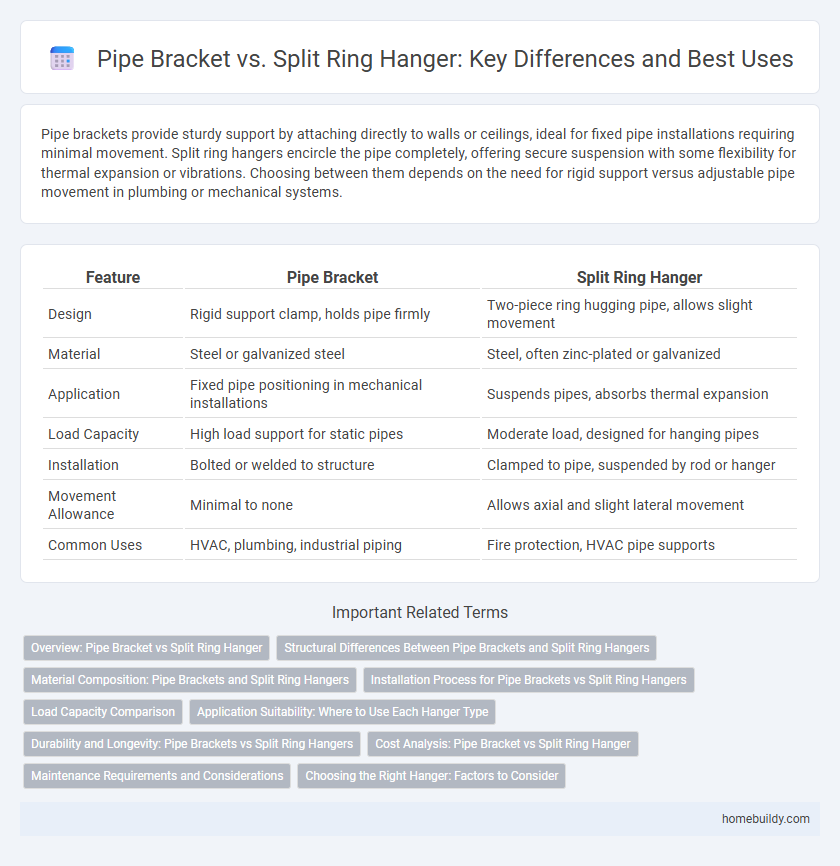Pipe brackets provide sturdy support by attaching directly to walls or ceilings, ideal for fixed pipe installations requiring minimal movement. Split ring hangers encircle the pipe completely, offering secure suspension with some flexibility for thermal expansion or vibrations. Choosing between them depends on the need for rigid support versus adjustable pipe movement in plumbing or mechanical systems.
Table of Comparison
| Feature | Pipe Bracket | Split Ring Hanger |
|---|---|---|
| Design | Rigid support clamp, holds pipe firmly | Two-piece ring hugging pipe, allows slight movement |
| Material | Steel or galvanized steel | Steel, often zinc-plated or galvanized |
| Application | Fixed pipe positioning in mechanical installations | Suspends pipes, absorbs thermal expansion |
| Load Capacity | High load support for static pipes | Moderate load, designed for hanging pipes |
| Installation | Bolted or welded to structure | Clamped to pipe, suspended by rod or hanger |
| Movement Allowance | Minimal to none | Allows axial and slight lateral movement |
| Common Uses | HVAC, plumbing, industrial piping | Fire protection, HVAC pipe supports |
Overview: Pipe Bracket vs Split Ring Hanger
Pipe brackets provide sturdy support and secure pipe alignment in various industrial and construction applications, ensuring minimal vibration and structural integrity. Split ring hangers offer flexible load distribution and easy installation, especially for vertical or horizontal pipe runs, reducing stress on piping systems. Comparing both, pipe brackets emphasize rigid fixation while split ring hangers prioritize adjustable suspension and enhanced load management.
Structural Differences Between Pipe Brackets and Split Ring Hangers
Pipe brackets provide rigid support by securing pipes with a fixed, solid clamp, ensuring minimal movement and high load-bearing capacity. Split ring hangers consist of a split ring that encircles the pipe, offering more flexibility and allowing slight pipe movement to accommodate thermal expansion. Structurally, pipe brackets are ideal for fixed, heavy-duty support, whereas split ring hangers are preferred in applications requiring vibration isolation and thermal expansion adjustments.
Material Composition: Pipe Brackets and Split Ring Hangers
Pipe brackets are commonly made from steel with a protective coating such as zinc or epoxy to enhance corrosion resistance, ensuring durability in various industrial applications. Split ring hangers typically utilize malleable iron or cast steel, providing robust support while accommodating pipe expansion and contraction. Both materials are selected for their mechanical strength and resistance to environmental factors, but split ring hangers may offer superior flexibility due to their design and material properties.
Installation Process for Pipe Brackets vs Split Ring Hangers
Pipe brackets offer a straightforward installation process, requiring simple mounting on walls or ceilings with screws or anchors, making them suitable for lighter, smaller pipes. Split ring hangers involve securing a two-piece clamp around the pipe and fastening it to a threaded rod or structural element, providing robust support for heavier or larger-diameter pipes. The choice between these methods depends on pipe size, weight, and the need for vibration isolation or thermal expansion accommodation.
Load Capacity Comparison
Pipe brackets provide higher load capacity compared to split ring hangers due to their robust design and material thickness, supporting heavier pipes and reducing deformation under pressure. Split ring hangers typically accommodate lighter loads, making them suitable for smaller pipes and less demanding applications. Engineers select pipe brackets for installations requiring enhanced structural support and durability in heavy-duty environments.
Application Suitability: Where to Use Each Hanger Type
Pipe brackets are ideal for rigid support in vertical and horizontal pipe installations, offering stability in industrial and commercial plumbing systems. Split ring hangers provide flexible support, making them suitable for suspended pipes that require vibration isolation and thermal expansion accommodation. Selecting between pipe brackets and split ring hangers depends on load requirements, installation environment, and pipe movement considerations.
Durability and Longevity: Pipe Brackets vs Split Ring Hangers
Pipe brackets offer superior durability due to their solid metal construction, providing enhanced support and resistance to deformation under heavy loads compared to split ring hangers, which are often made of lighter materials. The corrosion-resistant coatings on pipe brackets extend their longevity in harsh environments, making them ideal for long-term applications. Split ring hangers, while easier to install, may experience faster wear and require more frequent replacement in demanding settings.
Cost Analysis: Pipe Bracket vs Split Ring Hanger
Pipe brackets typically offer a lower initial cost compared to split ring hangers due to simpler manufacturing and materials. Maintenance expenses for pipe brackets remain minimal as they provide robust support without frequent adjustments, whereas split ring hangers may incur higher costs over time due to additional hardware and potential wear. Evaluating long-term budget impact, pipe brackets present a more cost-effective solution in heavy-duty and high-load piping systems.
Maintenance Requirements and Considerations
Pipe brackets require minimal maintenance due to their rigid structure and corrosion-resistant materials, making them ideal for long-term support in static installations. Split ring hangers, while offering adjustable support and vibration dampening, demand regular inspections to ensure the hanger components remain tight and corrosion-free to prevent pipe displacement. Maintenance protocols for split ring hangers often include lubrication of moving parts and replacement of worn-out cushioned inserts, unlike pipe brackets which have fewer moving components.
Choosing the Right Hanger: Factors to Consider
Selecting the right hanger involves evaluating load capacity, pipe material compatibility, and installation environment, where pipe brackets provide robust support for heavier pipes while split ring hangers offer flexibility with various pipe sizes. Consider vibration resistance and ease of maintenance, as pipe brackets typically reduce movement and noise, whereas split ring hangers facilitate quicker adjustments and replacements. Assess corrosion resistance based on the operational conditions, since materials like stainless steel brackets outperform standard split ring hangers in harsh or outdoor settings.
pipe bracket vs split ring hanger Infographic

 homebuildy.com
homebuildy.com